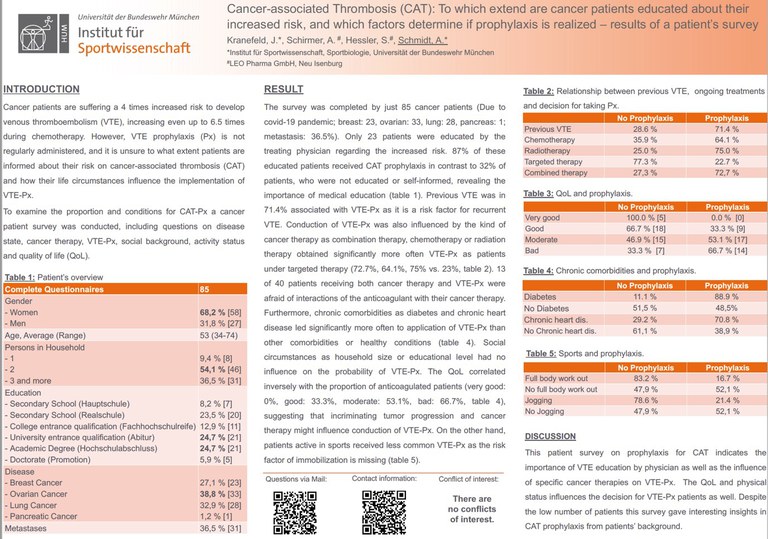
Cancer-associated Thrombosis (CAT): To which extend are cancer patients educated about their increased risk, and which factors determine if prophylaxis is realized – results of a patient’s survey
13 Oktober 2021
Abstract:
Cancer patients are suffering a 4 times increased risk to develop venous thromboembolism (VTE), increasing even up to 6.5 times during chemotherapy. However, VTE prophylaxis (Px) is not regularly administered, and it is unsure to what extent patients are informed about their risk on cancer-associated thrombosis (CAT) and how their life circumstances influence the implementation of VTE-Px.
To examine the proportion and conditions for CAT-Px a cancer patient survey was conducted, including questions on disease state, cancer therapy, VTE-Px, social background, activity status and quality of life (QoL).
The survey was completed by 85 cancer patients (breast: 23, ovarian: 33, lung: 28, pancreas: 1; metastasis: 36.5%). Only 23 patients were educated by the treating physician. 87% of these educated patients received CAT prophylaxis in contrast to 32% of patients, who were not educated or self-informed, revealing the importance of medical education. Previous VTE was in 71.4% associated with VTE-Px as it is a risk factor for recurrent VTE. Conduction of VTE-Px was also influenced by the kind of cancer therapy as combination therapy, chemotherapy or radiation therapy obtained significantly more often VTE-Px as patients under targeted therapy (72.7%, 64.1%, 75% vs. 23%). 13 of 40 patients receiving both cancer therapy and VTE-Px were afraid of interactions of the anticoagulant with their cancer therapy. Furthermore, chronic comorbidities as diabetes and chronic heart disease led significantly more often to application of VTE-Px than other comorbidities or healthy conditions. Social circumstances as household size or educational level had no influence on the probability of VTE-Px. The QoL correlated inversely with the proportion of anticoagulated patients (very good: 0%, good: 33.3%, moderate: 53.1%, bad: 66.7%), suggesting that incriminating tumor progression and cancer therapy might influence conduction of VTE-Px. On the other hand, patients active in sports received less common VTE-Px as the risk factor of immobilization is missing.
This patient survey on prophylaxis for CAT indicates the importance of VTE education by physician as well as the influence of specific cancer therapies on VTE-Px. The QoL and physical status influences the decision for VTE-Px patients as well. Despite the low number of patients this survey gave interesting insights in CAT prophylaxis from patients’ background.
Jahrestagung der Deutschen, Österreichischen und Schweizerischen Gesellschaften für Hämatologie und Medizinische Onkologie 2021, Berlin, 1.-4-.10.2021





